AMD's A10-5750M Review, Part 1: The APU and Radeon HD 8650G Performance
by Dustin Sklavos on June 28, 2013 12:00 PM ESTSystem and Futuremark Performance
While AMD's Enduro software is apparently still a mess on Intel-based systems, I actually found my only problem with it was messing with the interface to disable the MSI GX60's Radeon HD 7970M. For the purposes of isolating the A10-5750M's performance and giving it the best chance I could, I swapped in a second memory stick from the much maligned MSI GT70 Dragon Edition I recently reviewed and then disabled the 7970M.
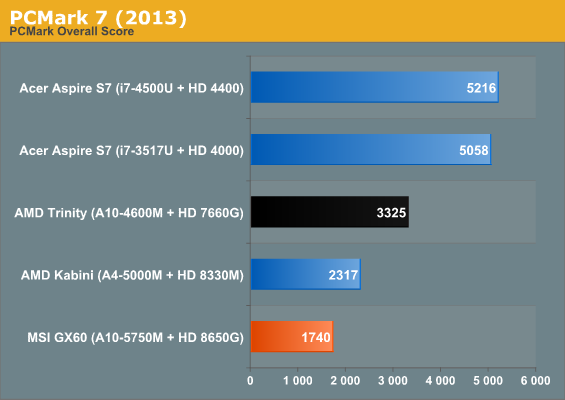
PCMark 7 is always going to respond primarily to the storage system, so the GX60's SSD takes a bath. What we want to see are scores that more directly isolate the performance properties of the A10-5750M itself.
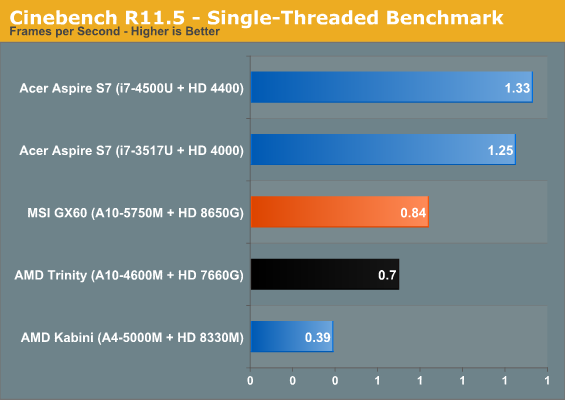
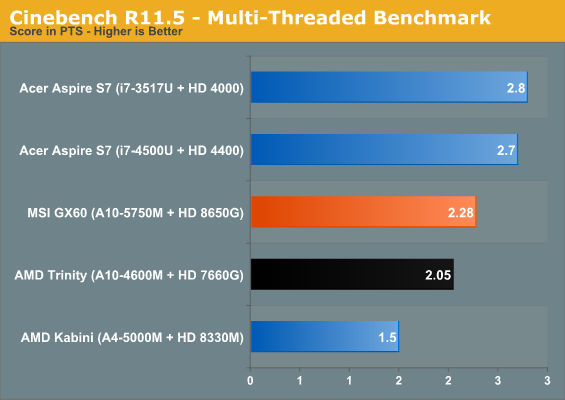
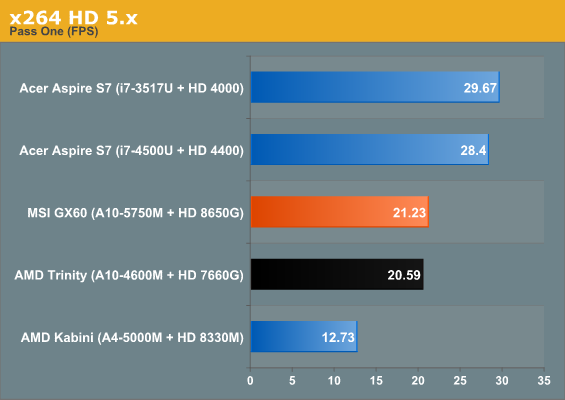
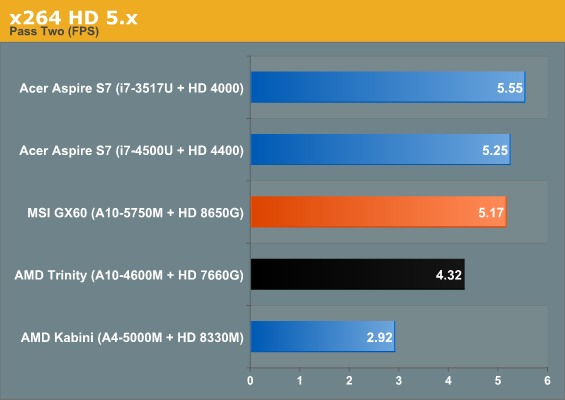
On the CPU side, we can see that Richland provides a healthy performance boost over Trinity. Only the first pass in our x264 benchmark doesn't show a notable jump, but the second pass boasts a remarkable 20% increase in performance. We're still some way from catching up to Haswell, much less Ivy Bridge, but I'll take the improvement where I can get it.
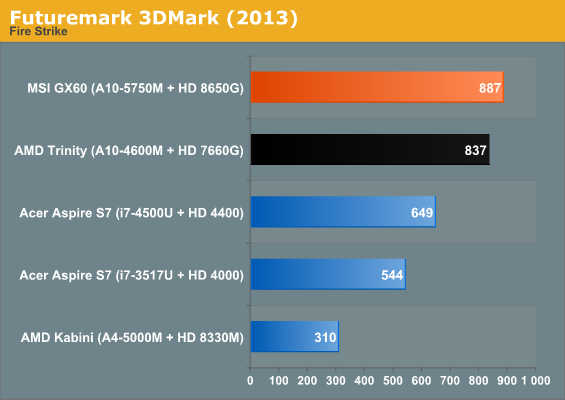
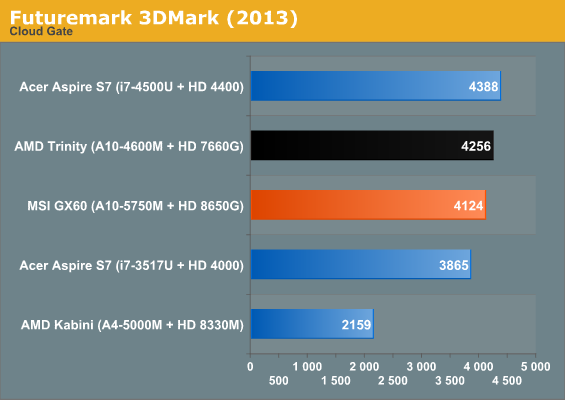
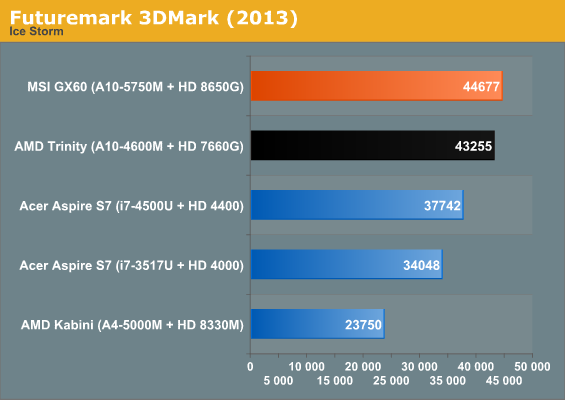
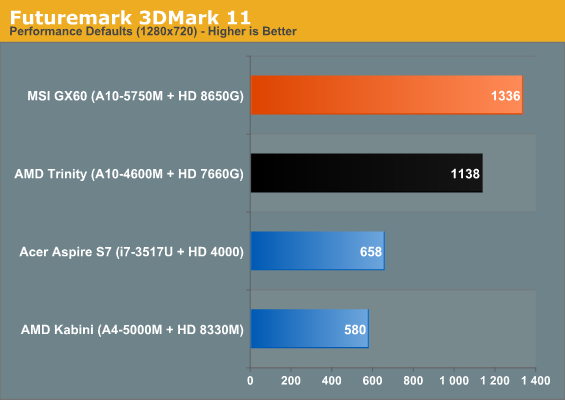
3DMark also continues to heavily favor AMD's on-die graphics, but while CPU performance got a healthy boost from Richland, the refresh doesn't move the needle on the graphics hardware nearly as much. It's generally improved apart from the odd results in the Cloud Gate test, but Richland's primary reason for being seems to be driving up CPU performance.










82 Comments
View All Comments
Vi0cT - Friday, June 28, 2013 - link
Still don't think 5100 can do a lot to the AMD A10-5750M GPU, I believe that at best it can offer equal performance to it and AMD stills wins in the price/performance (take into account driver optimizations too since ). Also VLIW is a more parallel architecture, so it should fare better in non-mainstream GPGPU stuff, however who runs that kind of stuff on a mobile device is beyond me, the best usage case I can think of (for a notebook) is Nebula 3 and the Volterra kernels on CUDA(Professional Audio) but that is on NVIDIA hardware.Still believe the market for both is a bit different, I mean Intel is focusing into getting more mainstream devices meanwhile AMD is kind of stuck in this kind of devices (GX60).
Even being better than the Intel solution price/performance-wise any design aimed at mainstream will prefer the Intel's lower TDP and power consumption.
whyso - Friday, June 28, 2013 - link
Look at the 4770k igp results from the iris pro article. It looks like HD 4600 SV is quite on par with even the top range of AMD's apus (4770k is around 10-15% faster than trinity, richland is marginally faster than trinity [sometimes slower] so it looks like 8650G is barely faster than HD 4600).Vi0cT - Saturday, June 29, 2013 - link
In the desktop Richland is 34% faster than the HD4600 in avg.The only comparison point we have here for now is 3DMark 11 (Sadly :/) and that puts Richland at 29% advantage vs the HD5100 in the MBA.
Again the peak theoretical performance difference between the HD4600 and the HD5000 is 63%. Between the HD5000 and the HD5100 there's is only 18.3% even taking into account throttling the best I can see the HD5100 doing is being on par with Richland.
Also take into account driver optimization and the optimization for AMD/NVIDIA's GPU architectures.
Still with Richland we're still talking about VLIW, with CGN (Kaveri) AMD will gain ground against Intel.
If done right AMD can get this performance into the 15-20W targets and beat Intel at 28-35W with less problems in CPU intensive games.
Khato - Friday, June 28, 2013 - link
Pricing is definitely a legitimate concern... too bad that we have no clue how much AMD's mobile parts even cost isn't it? They don't even publish recommended pricing. If we compare similar models that differ only in their processor manufacturer (Lenovo Edge E531 vs E535) then you're talking a $50 premium for the Intel chip on the base offering... though Intel's recommended pricing is the same for the upgraded i5-3230m as the base i3-3110m, so let's figure that the i5-3230m actually costs that recommended $225. In that case we arrive at roughly $100 for the base AMD Trinity and then something around $200 for the A10.Regardless it doesn't matter too much. For comparison, Iris Pro models start at a recommended price of $440 for the i7-4750HQ. And then all the non-i7 28W Iris parts have a recommended price of $342. But yeah, who knows what actual prices are? The i3-4158U (28W Iris 5100 part) may well be cheaper than AMD's A10-5750m. And as esgreat already stated, expect Iris 5100 to be quite a bit faster than HD 5000.
Vi0cT - Friday, June 28, 2013 - link
I'm pretty sure AMD is giving lower prices to OEMs (else they will get almost 0 design wins) many OEMs will try to get extra margins from the AMD. Also don't underestimate 50 USDs. In developing countries (being from one myself) what looks like "50 bucks" makes a huge difference for the avg Joe.It's the difference between the guy actually buying or not the AMD one.
Khato - Saturday, June 29, 2013 - link
Oh, I wouldn't be surprised if AMD is giving lower prices to OEMs for their low-end models. But they want to make more money on their 'high end' SKUs same as Intel. Heh, and if Intel's i3-4158U outperforms AMD's top end mobile offering then I'm sure that the AMD part will be priced a bit lower than it. But it's hard to claim that AMD has a massive lead in price/performance if that's the case. Regardless, it's all speculation since neither AMD nor Intel give real pricing information for mobile parts.Vi0cT - Saturday, June 29, 2013 - link
However we can see it like this, maybe both sell the SKUs at the same price (let's say 5% more or less whoever gets it) and the OEMs get those "50 bucks" just cause it says Intel (there is a lot of change that is happening), then it's not Intel's pricing problem :PVi0cT - Saturday, June 29, 2013 - link
there is a lot of chance*FwFred - Saturday, June 29, 2013 - link
Why would you think the maximum turbo rate has anything to do with the average GPU clock for a 15W part vs 28W?kyuu - Saturday, June 29, 2013 - link
There is no mobile GT3e part, so what are you even talking about. Or does your definition of "fair" somehow involve comparing mobile Richland to desktop Haswell?